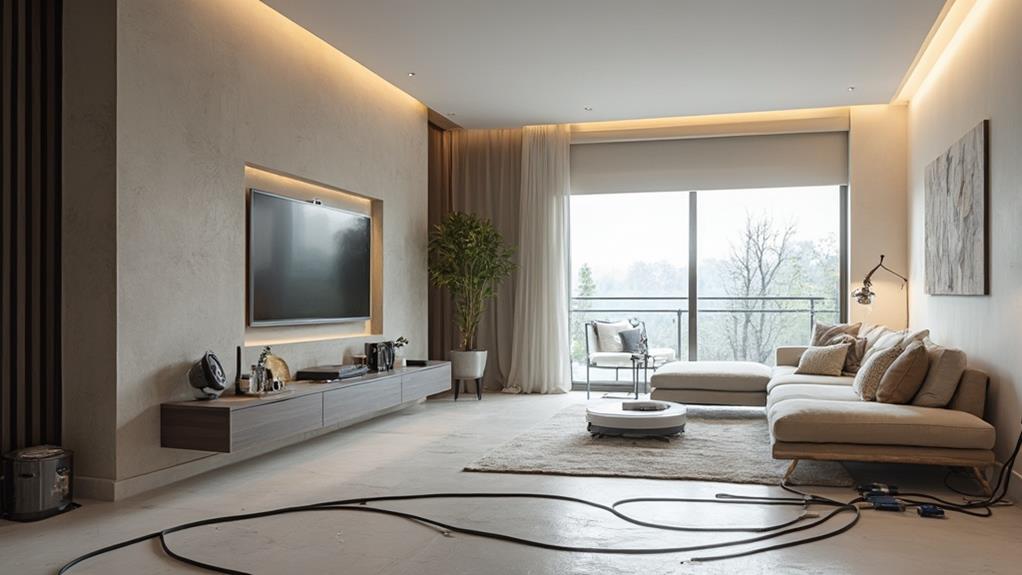Smart home integration during renovation requires careful planning to maximize functionality and efficiency. Begin by assessing your specific needs and lifestyle, considering areas where automation can enhance daily routines. Focus on robust infrastructure, including strategic wiring and Wi-Fi coverage, to support future technologies. Choose compatible devices that align with your preferred ecosystem and prioritize security measures to protect your connected home. Implement energy-efficient solutions through automated systems and consider voice control integration for seamless operation. By thoughtfully incorporating smart technology into your renovation, you'll create a home that's not only cutting-edge but also tailored to your unique preferences and requirements.
Assessing Your Smart Home Needs
Before diving into smart home integration, one must carefully evaluate their specific requirements and lifestyle. Consider the areas where automation could enhance daily routines, increase energy efficiency, or improve security. Assess which rooms or functions would benefit most from smart technology, such as lighting, climate control, or entertainment systems.
Analyze your family's habits and preferences to determine which features would be most useful. For instance, if energy conservation is a priority, focus on smart thermostats and automated lighting. If security is a concern, explore smart locks, cameras, and alarm systems. Consider the level of tech-savviness among household members to ensure the chosen solutions are user-friendly for everyone.
Evaluate your budget and prioritize investments accordingly. Some smart home features may offer immediate benefits, while others might be long-term investments. Research compatibility between different smart devices and platforms to ensure seamless integration. Consider future-proofing your home by selecting systems that can be easily upgraded or expanded. By thoroughly assessing your needs, you can create a tailored smart home plan that aligns with your goals and enhances your living experience.
Wiring and Infrastructure Considerations
Proper wiring and infrastructure are crucial foundations for a successful smart home integration. When planning your renovation, consider future-proofing your home by installing a robust network of Ethernet cables and strategically placed power outlets. This wired backbone will ensure reliable connectivity for smart devices and reduce dependence on potentially unreliable Wi-Fi signals.
Invest in a centralized hub or control panel to manage your smart home systems efficiently. This hub should be placed in an easily accessible location, preferably near your main electrical panel. Consider dedicated circuits for high-power smart devices like electric vehicle chargers or smart appliances to prevent overloading.
For optimal performance, plan for multiple Wi-Fi access points throughout your home to eliminate dead zones and ensure seamless coverage. Install conduits in walls and ceilings to facilitate future cable runs and upgrades. Don't forget to consider smart lighting systems, which may require special wiring or switches.
Lastly, prioritize cybersecurity by setting up a separate network for your smart devices, isolating them from your main home network. This precaution will help protect your personal data and maintain the integrity of your smart home system.
Choosing Compatible Smart Devices
With a solid infrastructure in place, selecting compatible smart devices becomes the next key step in creating a cohesive and efficient smart home ecosystem. When choosing smart devices, prioritize compatibility with major platforms like Amazon Alexa, Google Home, or Apple HomeKit. This ensures seamless integration and allows for centralized control through a single app or voice assistant.
Consider the specific needs of each room and choose devices accordingly. For example, smart thermostats can optimize energy usage, while smart lighting systems offer convenience and ambiance control. Security devices, such as smart locks and cameras, enhance home safety. When selecting appliances, opt for models with built-in Wi-Fi connectivity for remote control and monitoring.
Pay attention to the communication protocols used by different devices. Popular options include Wi-Fi, Zigbee, and Z-Wave. Ensure your chosen devices can communicate effectively within your network. Additionally, consider future expandability and upgradability when making selections. Opt for devices from reputable manufacturers with a track record of regular software updates and long-term support. This approach will help future-proof your smart home investment and ensure a smooth, integrated experience for years to come.
Security and Privacy Concerns
As smart homes become increasingly prevalent, security and privacy concerns take center stage in the integration process. Homeowners must carefully consider the potential vulnerabilities associated with connected devices and take proactive measures to safeguard their personal information and home security.
One primary concern is the risk of unauthorized access to smart home systems. Hackers may exploit weak passwords or unsecured networks to gain control over devices, potentially compromising physical security or accessing sensitive data. To mitigate these risks, users should implement strong, unique passwords for each device and regularly update firmware and software.
Another key issue is data privacy. Smart devices often collect and transmit vast amounts of personal information, raising questions about how this data is stored, used, and shared. Homeowners should carefully review privacy policies and opt for devices from reputable manufacturers with robust data protection practices.
Network segmentation can provide an additional layer of security by isolating smart home devices from other network-connected devices. This approach limits potential damage if a single device is compromised. Additionally, using a virtual private network (VPN) can encrypt data transmitted between smart devices and external servers, further enhancing privacy and security in the smart home ecosystem.
Energy Efficiency Through Automation
Smart home automation offers significant potential for enhancing energy efficiency in residential settings. By integrating intelligent control systems, homeowners can optimize energy usage, reduce waste, and lower utility costs. Automated thermostats, for instance, learn occupants' schedules and preferences, adjusting temperature settings accordingly to minimize unnecessary heating or cooling.
Lighting automation plays a crucial role in energy conservation. Motion sensors and programmable schedules ensure lights are only active when needed, while smart bulbs allow for precise control over brightness and color temperature. Similarly, automated window treatments can help regulate indoor temperatures by adjusting based on sunlight and time of day.
Smart appliances contribute to energy efficiency by operating during off-peak hours and self-regulating their power consumption. Energy monitoring systems provide real-time data on electricity usage, enabling homeowners to identify and address inefficiencies. Additionally, smart power strips can automatically cut power to devices in standby mode, eliminating phantom energy draw.
Voice Control and AI Integration
At the heart of modern smart home systems lies voice control and AI integration, revolutionizing the way users interact with their living spaces. Voice-activated assistants like Amazon Alexa, Google Assistant, and Apple's Siri have become central hubs for managing smart devices, offering hands-free control over lighting, temperature, security systems, and entertainment.
These AI-powered assistants learn user preferences and habits over time, enabling them to anticipate needs and automate routines. For example, a system might recognize when residents typically arrive home and adjust lighting and temperature accordingly. Voice control allows users to effortlessly manage multiple devices simultaneously, such as dimming lights, playing music, and locking doors with a single command.
When planning for voice control and AI integration in a renovation, consider:
- Choosing a compatible ecosystem (e.g., Amazon, Google, Apple)
- Installing smart speakers or displays in key areas
- Ensuring robust Wi-Fi coverage throughout the home
- Selecting smart devices that integrate with your chosen AI assistant
- Configuring custom voice commands and routines
- Implementing necessary privacy safeguards
Future-Proofing Your Smart Home
When designing a smart home system, future-proofing is essential to ensure longevity and adaptability. Consider implementing a modular infrastructure that allows for easy updates and expansions as technology evolves. Choose open-source platforms and protocols that support interoperability between devices from different manufacturers, ensuring your system remains flexible and upgradeable.
Invest in robust, high-speed networking capabilities, including Wi-Fi 6 or Wi-Fi 6E routers and ethernet wiring throughout your home. This foundation will support the increasing bandwidth demands of future smart devices and applications.
Additionally, plan for adequate power distribution, including strategically placed outlets and USB ports to accommodate new devices.
Consider the potential for emerging technologies, such as 5G integration, augmented reality interfaces, and advanced AI assistants. Design spaces that can easily incorporate these future innovations without major renovations. Implement scalable storage solutions for data generated by smart devices, either through local servers or cloud-based services.
Regularly update your system's software and firmware to maintain security and compatibility with new devices. By prioritizing flexibility, scalability, and future compatibility in your smart home design, you can create a system that evolves with technological advancements and your changing needs.
Budgeting for Smart Technology
While implementing smart home technology can significantly enhance convenience and efficiency, it's crucial to establish a well-planned budget to ensure a cost-effective and sustainable integration. Begin by prioritizing your smart home goals and identifying essential features that align with your lifestyle. Research various brands and models to compare prices and functionality, keeping in mind that higher-priced options may offer better long-term value through improved reliability and extended support.
Consider allocating funds for professional installation, especially for complex systems like smart electrical wiring or advanced security setups. Factor in ongoing costs such as subscription fees for cloud services or software updates. It's wise to set aside a contingency fund for potential upgrades or replacements as technology evolves.
To maximize your budget, look for compatible devices that work with a single ecosystem, reducing the need for multiple hubs or controllers. Take advantage of sales, bundles, and energy-efficient products that may qualify for rebates or tax incentives. By carefully planning your smart home budget, you can create a technologically advanced living space without overspending or compromising on quality.
Frequently Asked Questions
How Long Does It Typically Take to Install a Complete Smart Home System?
The installation time for a complete smart home system typically varies from a few days to several weeks, depending on the size of the home, complexity of the system, and extent of required wiring or retrofitting.
Can Smart Home Devices Be Easily Moved When Relocating to a New House?
Imagine a house that moves with you! Smart home devices are generally portable, allowing for easy relocation. Most can be uninstalled and reinstalled in a new home, though some wired systems may require professional assistance during the transition process.
Are There Professional Certifications for Smart Home Installation Specialists?
Yes, there are professional certifications for smart home installation specialists. Organizations like CEDIA offer certifications such as ESC-T (Electronic Systems Certified Technician) and ESC-D (Electronic Systems Certified Designer) for professionals in the smart home industry.
How Do Smart Home Systems Impact Home Insurance Premiums?
According to J.D. Power, 57% of homeowners with smart home devices report lower insurance premiums. Smart home systems can positively impact insurance costs by reducing risks associated with theft, fire, and water damage, potentially leading to discounts from insurers.
What Happens to Smart Home Functionality During Extended Power Outages?
During extended power outages, smart home functionality is significantly impaired. Most devices rely on electricity and internet connectivity to operate. Battery-powered devices may continue working briefly, but overall system performance and control capabilities are severely limited without power.
Conclusion
As the digital tapestry of smart home technology continues to weave itself into the fabric of modern living, careful planning becomes paramount. Like a well-conducted symphony, seamless integration of smart devices can transform a house into a responsive, efficient sanctuary. By addressing infrastructure, compatibility, security, and future scalability, homeowners can craft an intelligent living space that not only meets current needs but also adapts to the ever-evolving landscape of home automation, creating a harmonious blend of comfort and innovation.

